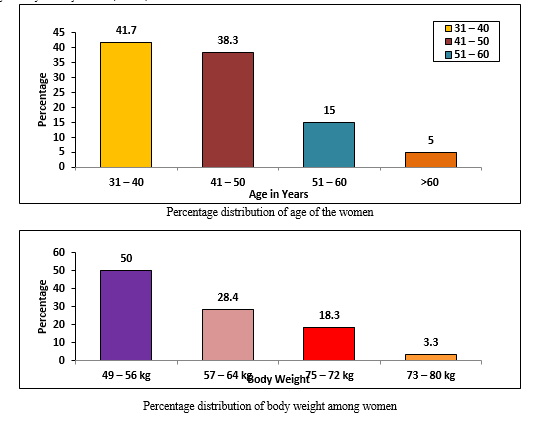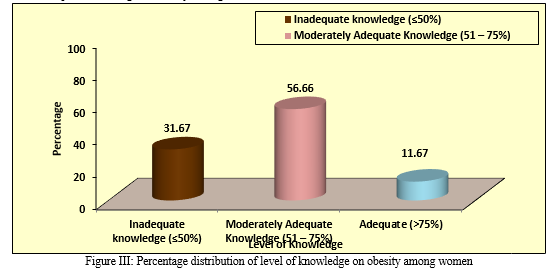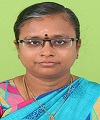Ijraset Journal For Research in Applied Science and Engineering Technology
- Home / Ijraset
- On This Page
- Abstract
- Introduction
- Conclusion
- References
- Copyright
Assess the Knowledge on Obesity among Women Residing in Urban Areas at Chennai
Authors: Meena P, Francis Nath, F. J. David
DOI Link: https://doi.org/10.22214/ijraset.2022.46840
Certificate: View Certificate
Abstract
Introduction: Obesity is a complex condition, one with serious social and psychological dimensions, that affects virtually all age and socio-economic groups and threatens to overwhelm both developed and developing countries. As in developed societies, the risk for obesity in developing countries is also strongly influenced by diet and lifestyle, which are changing dramatically as a result of the economic and nutrition transition. Obesity is a key risk factor in the natural history of non-communicable diseases like hypertension. Objectives ? To assess the knowledge on obesity among women. ? To find out the association between knowledge among women with selected demographic variables. Methodology: A descriptive study was used to assess the knowledge on obesity among women residing in urban areas. After obtaining permission from the Department of Community Heath Nursing, the investigator selected 60 samples by using purposive sampling technique. The samples who met the inclusion criteria were selected for study, the investigator introduced and explained the purposes of the study to the samples and obtained the written informed consent. The nature and purpose of the study was explained to the women. Questionnaire was used to collect the demographic variables of women. Result: The results shows that 34(56.66%) had moderately adequate knowledge, 19(31.67%) had inadequate knowledge and 7(11.67%) had adequate knowledge on obesity among women. The above table 3 shows that the mean score of knowledge on obesity among women was 12.03±2.52. The median score was 11.0 with minimum score of 8.0 and maximum score of 18.0. Conclusion: The present study concluded women had inadequate to moderate knowledge on obesity and the study suggests that the women in the community should be educated on the risk of obesity and necessary measures to be taken on it.
Introduction
I. INTRODUCTION
Obesity is a complex condition, one with serious social and psychological dimensions, that affects virtually all age and socio-economic groups and threatens to overwhelm both developed and developing countries(1) (World Health Organization, 2015). As in developed societies, the risk for obesity in developing countries is also strongly influenced by diet and lifestyle, which are changing dramatically as a result of the economic and nutrition transition.(2) Obesity is a key risk factor in the natural history of non-communicable diseases like hypertension(3)
Obesity can occur at any age and generally increased with age. Women generally have higher rate of obesity than men, although men may have higher rate of overweight in the Framingham, USA study, men were found to gain most weight between the ages of 29 and 35 years, while women gain most between 45 and 49 years of age(4) (Amudha P, Lorna A., 2016). In developing and developed countries, obesity has reached epidemic proportions. In India obesity is reaching epidemic proportions, with morbid obesity affecting 5% of the population. Indians are genetically predisposed to fat accumulation particularly around the waist (5)
According to national family health survey data the prevalence of overweight and obesity is highest in north India, (6)with percentage being high as 30% in males and 37.5% in females, whereas the states in North-east India have a comparatively lower prevalence of 5- 8% in males and 5% to 9% in females, national average being 8%. (7)According to the world health organization (WHO) there will be about 2.3 billion overweight people aged 15 years and above and over 700 million obese people worldwide in 2015.Overweight and obesity are the fifth leading risk of death, resulting in around 2.8 million death of adults globally every year.(8)
According to WHO global estimates, about 13% of the world’s adult population (11% of men and 15% of women) were obese in 2014(9) Prevalence of obesity varies according to age, sex and region. In India the percentage of ever married women aged 15-49 years who are overweight or obese increased from 11% in National Family Health Survey(10) (NFHS)-2 to 15% in NFHS-3. The percentage of women who are overweight or obese is highest in Punjab (29.9%), followed by Kerala (28.1%) and Delhi (26.4%)(11)
Body fat content is 25% for women at normal size compared to 15% for men. All other things being equal, such as age and exercise levels, women require fewer calories per pound of body weight daily than do men. Female hormones make it easier to convert fat into food. (12) Women more often do the cooking in the households. Finally, in fatprone women, birth control pills cause the body to produce increased amounts of fat and water. Estrogen alone will cause increased deposition of fat. Sedentary lifestyle particularly sedentary occupation and inactive recreation such as watching television promote of mortality and morbidity related to overweight and obesity, obesity is associated with higher socio-economic groups
II. MATERIALS AND METHODS
A descriptive study was used to assess the knowledge on obesity among women residing in urban areas. After obtaining permission from the Department of Community Heath Nursing, the investigator selected 60 samples by using purposive sampling technique. The samples who met the inclusion criteria were selected for study, the investigator introduced and explained the purposes of the study to the samples and obtained the written informed consent. The nature and purpose of the study was explained to the women. Data were collected using a structured questionnaire. Confidentiality was maintained throughout the study. The project was approved by the institutional ethics committee.
III. RESULTS AND DISCUSSION
A. Section A: Description Of The Demographic Variables Of Women
Description of Sample Characteristics
The study shows that most of the women, 25(41.7%) were aged between 31–40 years, 29(48.3%) had higher secondary education and were private employees, 33(55%) had monthly family income of Rs.10,000 – 15,000, 51(85%) belonged to nuclear family,35(58.4%) were mixed diet, 39(65%) had walking as exercise, 30(50%) were weighing between 49 – 56 kg, 46(76.7%) had no family history obesity and 32(53.3%) were normal.

B. Section B: Assessment Of Level Of Knowledge On Obesity Among Women
Table 2: Frequency and percentage distribution of level of knowledge on obesity among women.
N= 60
|
Level of Knowledge |
Frequency (F) |
Percentage (%) |
|
Inadequate knowledge (≤50%) |
19 |
31.67 |
|
Moderately Adequate Knowledge (51 – 75%) |
34 |
56.66 |
|
Adequate (>75%) |
7 |
11.67 |
The above table shows that 34(56.66%) had moderately adequate knowledge, 19(31.67%) had inadequate knowledge and 7(11.67%) had adequate knowledge on obesity among women.

Table 3: Assessment of knowledge scores on obesity among women.
N = 60
|
Knowledge |
Score |
|
Minimum score |
8.0 |
|
Maximum score |
18.0 |
|
Median |
11.0 |
|
Mean |
12.03 |
|
S.D |
2.52 |
The above table 3 shows that the mean score of knowledge on obesity among women was 12.03±2.52. The median score was 11.0 with minimum score of 8.0 and maximum score of 18.0.
The study was supported by Shrivastava S., Shrivastava P., Ramasamy J (2013) conducted a study to assess the knowledge of medical students pertaining to obesity. A cross-sectional descriptive study was conducted among first-year medical students in March of 2013.. The total sample included 138 students. A lack of physical activity and the presence of stress were identified as the most common risk factors for obesity development. (13) Approximately, 73(52.9%) students were of the incorrect opinion about obesity. The most common strategy cited by 107(77.5%) respondents for prevention of obesity was regular exercise. The study revealed that although the majority of the medical students were aware of the risk factors of obesity, many gaps, which need to be bridged, were identified in their knowledge. These medical students could be actively involved in awareness campaigns for delaying the onset of lifestyle diseases.
C. Section D: Association Of Level Of Knowledge With Selected Demographic Variables
Table 4: Association of level of knowledge among women with their selected demographic variables. N = 60
|
Demographic Variables |
Frequency |
Chi-Square & p-value |
|
Age in years |
|
χ2=9.042 d.f=6 p=0.171 N.S |
|
31 – 40 |
25 |
|
|
41 – 50 |
23 |
|
|
51 – 60 |
9 |
|
|
>60 |
3 |
|
|
Educational status |
|
χ2=5.732 d.f=6 p=0.454 N.S |
|
Primary education |
5 |
|
|
Secondary education |
19 |
|
|
Higher secondary |
29 |
|
|
Diploma / Degree |
7 |
|
|
Occupation |
|
χ2=4.745 d.f=6 p=0.577 N.S |
|
Housewife |
29 |
|
|
Private employee |
19 |
|
|
Government employee |
5 |
|
|
Sedentary worker |
7 |
|
|
Monthly family income |
|
χ2=2.743 d.f=4 p=0.602 N.S |
|
Rs.5,000 – 10,000 |
2 |
|
|
Rs.10,000 – 15,000 |
33 |
|
|
Rs.15,000 – 20,000 |
25 |
|
|
Nil |
- |
|
|
Type of family |
|
χ2=1.784 d.f=2 p=0.410 N.S |
|
Nuclear family |
51 |
|
|
Joint family |
9 |
|
|
Dietary pattern |
|
χ2=1.598 d.f=4 p=0.809 N.S |
|
Vegetarian |
5 |
|
|
Non-vegetarian |
20 |
|
|
Mixed diet |
35 |
|
|
Type of exercise |
|
χ2=4.522 d.f=6 p=0.606 N.S |
|
Walking |
39 |
|
|
Breathing exercise |
3 |
|
|
Yoga |
15 |
|
|
No other |
3 |
|
|
Body weight |
|
χ2=2.298 d.f=6 p=0.890 N.S |
|
49 – 56 kg |
30 |
|
|
57 – 64 kg |
17 |
|
|
75 – 72 kg |
11 |
|
|
73 – 80 kg |
2 |
|
|
Family history of obesity |
|
χ2=2.552 d.f=2 p=0.279 N.S |
|
Yes |
14 |
|
|
No |
46 |
|
|
BMI |
|
χ2=3.794 d.f=6 p=0.704 N.S |
|
Underweight |
7 |
|
|
Normal |
32 |
|
|
Overweight |
18 |
|
|
Obese |
3 |
N.S – Not Significant
The table 4 shows that the demographic variables did not show statistically significant association with level of knowledge on obesity among women
The study was supported by Kanchana. K(2021) conducted a descriptive study on prevenlence of obesity among women by calculating BMI among women in an urban area of selected city. Sample size 50 was selected by using convenient sampling technique. (14) Procedure: A self-preparing data collection technique was used in order to obtain data, measured physical characteristics such as height and weight.. Out of 50 samples 15(30%) women are underweight, 10(20%) women’s having normal body weight, 10 (20%) women overweight and 15(30%) are obese. Demographic variables age, religion, education, occupation and socio-economic status not associated with obesity. Prevalence of overweight was high as compared to obesity in community area; the history of any other illness and medications was strongly associated with obesity(15) Obesity is the main cause of chronic illness and risk of being obese is increasing in women, so this study aims to identify the prevalence of generalized obesity among selected urban community people and identifying the influencing factors for the same.
IV. ACKNOWLEDGEMENT
We would like to extend our gratitude to the authorities of Saveetha College of Nursing and Saveetha Medical College Hospital for this study.
V. AUTHORS CONTRIBUTION
All the authors actively participate in the work of study. All the authors read and approved the final manuscript.
VI. CONFLICT OF INTEREST
The authors declare no conflict of interest
Conclusion
The present study concluded women had inadequate to moderate knowledge on obesity and the study suggests that the women in the community should be educated on the risk of obesity and necessary measures to be taken on it.
References
[1] Benkeser R. M., Biritwum .R, et al., Prevalence Of Overweight And Obesity And Perception Of Healthy And Desirable Body Size In Urban, Ghanaian Women. Ghana Medical Jou, 2012 .vol (46) No 2. [2] Chandiralekha M, et al., A Descriptive Study to Assess the Risk Factors of Obesity among Housewives Residing at Selected Community, Setting in Kanchipuram District, Tamil Nadu. Medico-legal Update, April-June 2020. vol (20), No.2 [3] Eden R Cardozo, et al., Knowledge of Obesity and Its Impact on Reproductive Health Outcomes among Urban Women. J Community Health. April 2013, vol 38(2). 261–267. [4] Girdhar S, Sharma S, Chaudhary A, Bansal P, Satija M. An epidemiological study of overweight and obesity among women in an Urban area of North India. Indian J Community Med 2016 (41):154-7. [5] Indrapal Meshram, et al., Prevalence of overweight/obesity, hypertension and its associated factors among women from Northeast India. Indian Heart Journal 2022. 74, 56-62. [6] Kanchana. K.et al., A Descriptive Study to Assess the Prevalence of Obesity among women in an urban area of selected city. Asian Journal of Nursing Education and Research, 2021.vol (11), Issue – 3. [7] Monali Suresh Patil and Reshma Bodhak . et al., Incidence of obesity and Perceived health problems among women. Sinhgad College of Nursing, 2017 vol (7), Issue I. [8] Nagar, Noopur, et al., Study on prevalence of obesity using different scales and its association with hypertension among the elderly in a district of Gujarat. Journal of Family Medicine and Primary Care: January 2022 vol (11), Issue 1 - p 162-169. [9] Nozipho Becker, Andile Mkhonta, et al., The prevalence of overweight/obesity and its association with household food insecurity among women living with HIV in rural Eswatini. BMC Public Health.2022. vol (22), Article number: 62. [10] Pakhide V.et al., A descriptive study to assess the prevalence of overweight and obesity by calculating BMI (Body Mass Index) among women at selected community area of Bhopal, Madhya Pradesh, India. Public Health Rev Int J Public Health Res.; 2020. (6):214-218. [11] Poornima Ramasamy and David Njeru.et al., A study to assess knowledge and perception on obesity among female aged eighteen years and above living in ladies dorm at UEAB, Kenya. International Journal of Research in Medical Sciences 2018. 6(5):14. [12] Rajendra Pradeepa, et al., prevalence of generalized & abdominal obesity in urban & rural. India- the icmr-indiab study (phase-i) [icmr-indiab-3]. Indian J Med Res 142, August 2015, pp 139-150. [13] Ramasamy P, David N, Zipporah W, et al., A study to assess knowledge and perception on obesity among female aged eighteen years and above living in ladies dorm at UEAB, Kenya. Int J Res Med Sci; 2018 (6):1496-1501. [14] Shrestha S, Asthanee S, et al. Perception of obesity and overweight among adults living in suburban Nepal: a qualitative study. BMJ Open; 11:e043719. Doi: 10.1136/ bmjopen-2020-04371. [15] Shrivastava S., Shrivastava P, et al., Assessment of knowledge about obesity among students in a medical college in Kancheepuram district, Tamil Nadu. Prog Health Sci 2013, Vol (3), No.1.
Copyright
Copyright © 2022 Meena P, Francis Nath, F. J. David. This is an open access article distributed under the Creative Commons Attribution License, which permits unrestricted use, distribution, and reproduction in any medium, provided the original work is properly cited.

Download Paper
Paper Id : IJRASET46840
Publish Date : 2022-09-21
ISSN : 2321-9653
Publisher Name : IJRASET
DOI Link : Click Here
 Submit Paper Online
Submit Paper Online

